An Homage to Tadeusz Rolke in 10 Photographs
Tadeusz Rolke, hailed as an icon and legend of Polish photojournalism, died in his native Warsaw in July 2025, at the age of 96. He dedicated his...
Guest Author 6 October 2025
Salvador Dalí and Philippe Halsman’s 37-year collaboration challenged viewers and revealed connections between the traditionally realistic medium of photography and the puzzling visual paradoxes of Surrealism. These two artists pushed one another into new creative spaces. At the same time, in their work together, it’s easy to spot the hallmarks of their individual aesthetics.
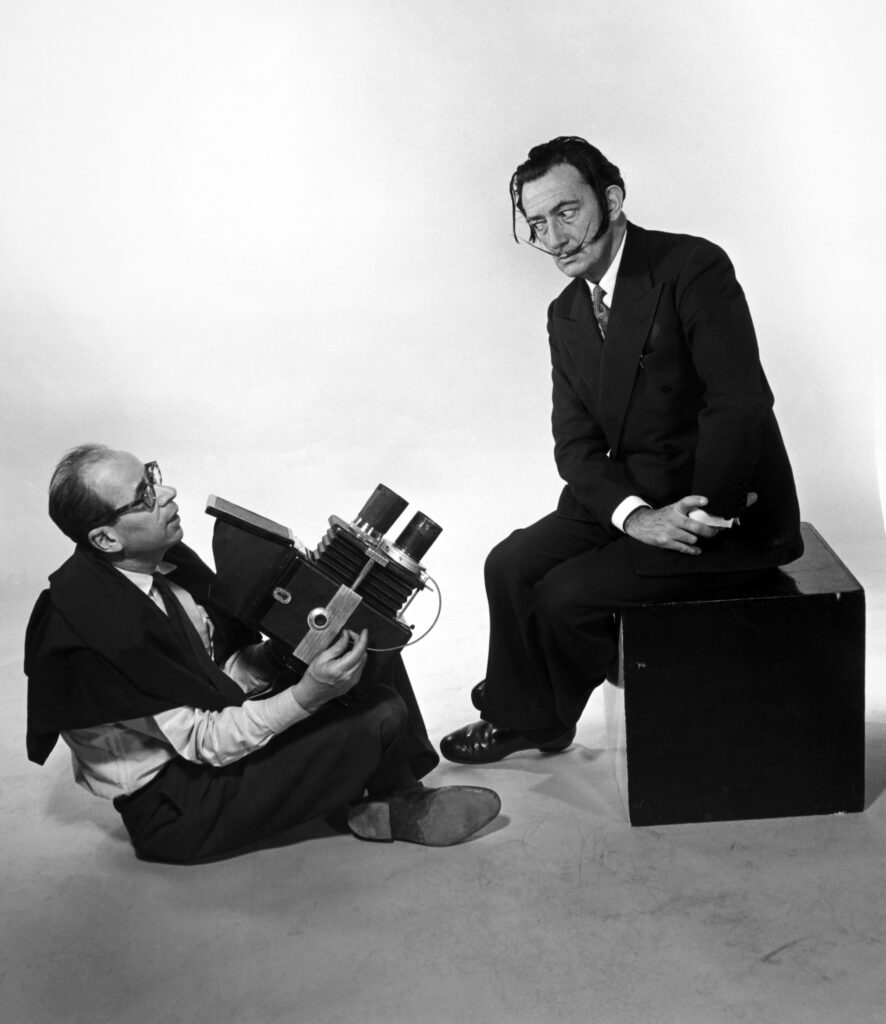
The Interview, 1954, Photograph by Yvonne Halsman. © Philippe Halsman Estate 2023. Philippe Halsman Archive.
Dalí’s complex philosophies and his iconography of clock faces, flies, and eggs appear in the Dalí-Halsman collaborations. Likewise, Halsman used his “jumpology” technique with Dalí, sending the famous painter into the air years before he applied the same approach to portraiture of other prominent celebrities.
Halsman’s photography helped make Dalí himself a work of art. In this way, Dalí was a precursor to Warhol’s iconic blond wig at Studio 54 and Ken Kesey’s magic bus ride, examples of an artist’s image becoming as important as the art they created.
Both Halsman and Dalí fled to the United States after the 1940 German invasion of France. They brought with them a firm understanding and appreciation of the Paris-born Surrealist movement. While artists like René Magritte, Max Ernst were reimagining painting, photographers like Man Ray and Dora Maar were bending the medium of photography. Dalí and Halsman found a way to fuse the two art forms.
The two artists met in 1941 when Halsman was on assignment covering a Dalí exhibit in New York City. Later that year, Halsman was hired to take pictures of the Dalí-designed set and costumes for Ballet Russes’ Labyrinth. Halsman’s photo of ballerina Tamara Toumanova and another dancer dressed in a giant rooster costume became Life magazine’s “Picture of the Week.”

Philippe Halsman for Life Magazine, 1941. Google Books. Detail.
A year later, Halsman created an image of Dalí in an egg in the photograph Prenatal Memory. However, the 1948 Dalí Atomicus proved one of their most enduring and complex collaborative projects.
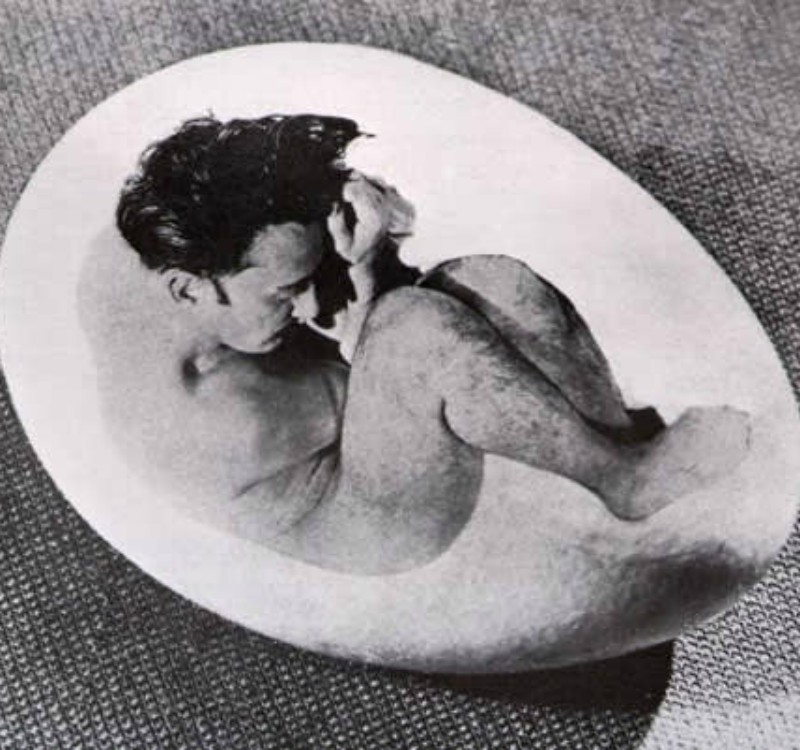
Philippe Halsman, Prenatal Memory, 1942. The Voice of Fashion.
After World War II, Dalí entered his “Nuclear Mysticism” phase, a reaction to the nuclear age and the devastating destruction of the bombing of Hiroshima and Nagasaki. The result was several works showing a mix of suspension and motion, including Leda Atomica.
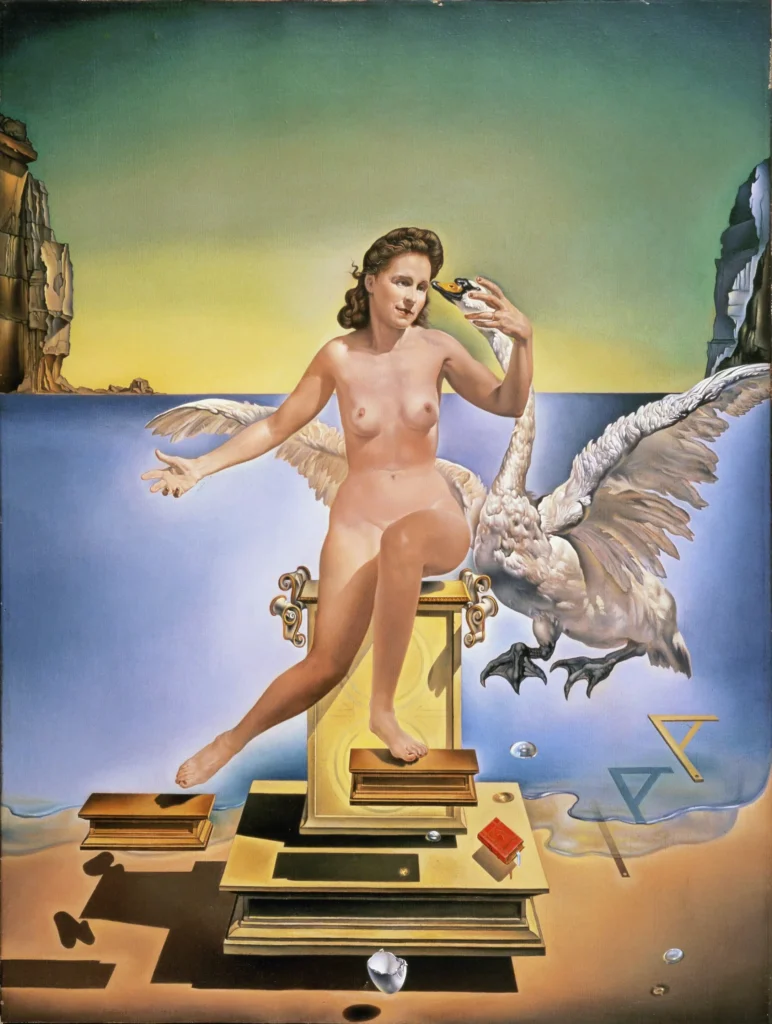
Salvador Dalí, Leda Atomica, 1949, Dalí Theatre and Museum, Figueres, Spain. Museum’s website.
After seeing the painting, Halsman told Dalí he’d like to create a similar image with Dalí at the center—Dalí Atomicus. Together, with some visual trickery and 26 takes, they succeeded in creating a photograph in which everything is suspended in motion. Halsman’s daughter Irene recalls having the job of wrangling and drying the cats between shoots. Halsman’s wife, Yvonne, held the chair by one leg just outside the frame of the photo so that it looked airborne.
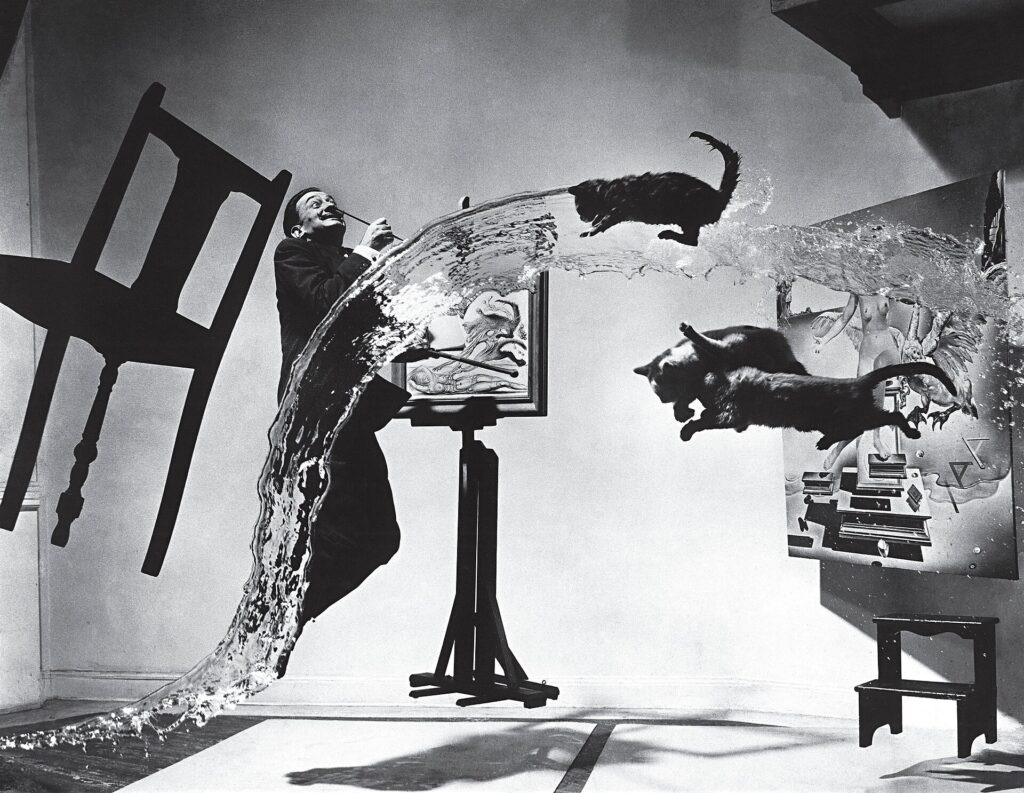
Philippe Halsman, Dalí Atomicus, 1948. Wikimedia Commons (CC BY-SA 2.0).
Between each attempt, Halsman would develop the picture to see if it was up to his standards before setting up the scene again. When he finally got the print he wanted, Dalí hand-painted the work shown on the easel. The result is an impossible-looking image that Time magazine named one of the 100 most influential photographs of all time.
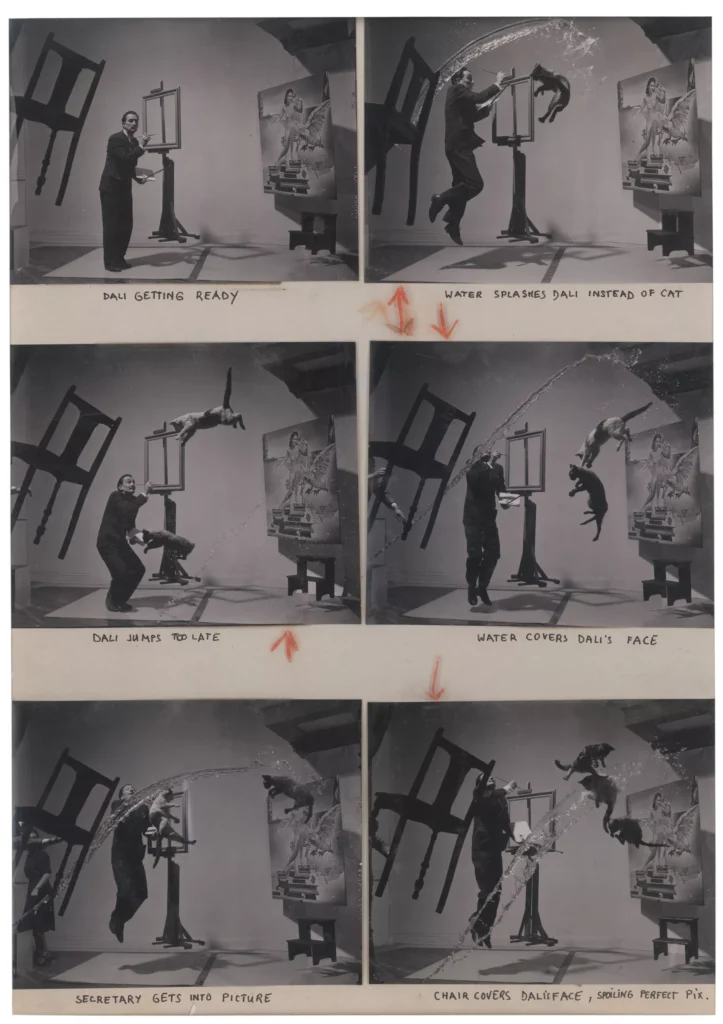
Philippe Halsman, Dali Atomicus photoshoot, 1948. © Philippe Halsman/Magnum Photos. Artsy.
When you ask a person to jump, his attention is mostly directed toward the act of jumping and the mask falls so that the real person appears.
While Halsman had been fascinated with jumping for some time, it was after Dalí Atomicus that he took photographs of Marilyn Monroe, Richard Nixon, Audrey Hepburn, and many others jumping. He published Jump Book, a book of these “jumpology” photographs, in 1959.
Dalí had a complex relationship with sex. As an adolescent, Dalí’s father, who frequented sex workers, warned his son about the dangers of sexually transmitted diseases and even went as far as to show Dalí photographs of syphilitic lesions.
As an adult, Dalí showed an acceptance and exploratory interest in people of all genders and sexualities, hosted orgies, and yet remained repressed and frightened of engaging in intercourse himself. Dalí adored his wife, Gala, who was also the model for Leda Atomicus. The two rarely, if ever, had sex, though Dalí was aware and intrigued by her many affairs.
Several of Dalí’s works examined the juxtaposition of sex and death, and more specifically, the allure of the female form interplaying with the horror of a human skull. Ballerina in the Head of Death, his sketch Escena de cafè (Café Scene), and his anti-venereal disease poster for World War II soldiers all use the female form to create skulls.
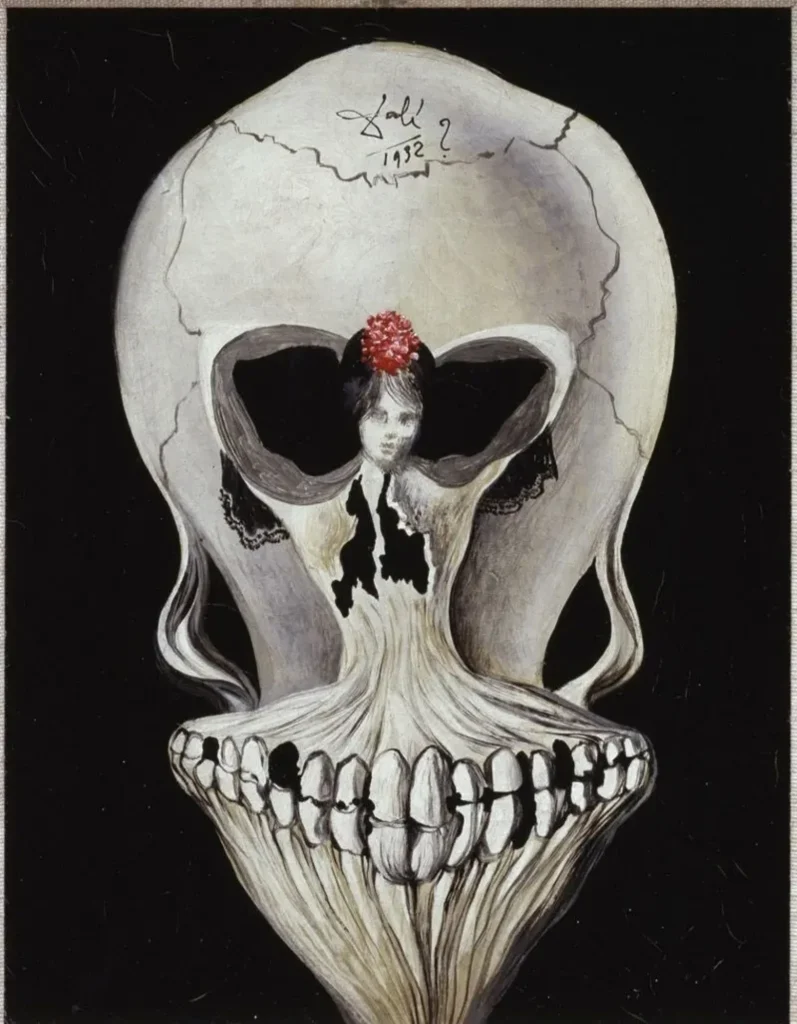
Salvador Dalí, Ballerina in the Head of Death, 1939, private collection. Arthive.
Halsman possessed an uncanny ability to translate Dalí’s complex ideas into photographs, and in this case, that meant creating an optical illusion using live models. In Voluptas Mors (translated from Latin as “voluptuous death” or “pleasure death”), Halsman places Dalí, in a top hat, in the frame as the ringmaster of the macabre. The complexity of the photograph is part of its allure, and as with Dalí Atomicus, the shoot took hours, a painstaking process of trial and error. The result is an image that looks too impossible to be real.

Philippe Halsman, Voluptas Mors, 1951. © Philippe Halsman/Magnum Photos. Wikimedia Commons (CC BY-SA 2.0).
Dalí is almost as well known for his image and persona as he is for his most famous paintings. No doubt, he worked hard to publicly display his eccentricities, from appearing on The Dick Cavett Show with a pet anteater to describing himself as a painter-clown in an interview with Mike Wallace.
By making Dalí the subject of his art, Halsman’s work propelled Dalí’s celebrity. The 1954 book Dali’s Mustache: A Photographic Interview is formatted as a series of questions posed to Dalí. All of them are answered in an absurdist way, featuring a peculiar portrait and prominently showcasing his trademark mustache twisted or reconfigured in a playful, surrealist manner.

Philippe Halsman, Spanish Painter Salvador Dalí, 1954. © Philippe Halsman/Magnum Photos. Magnum Photos.
In Dalí’s preface and Halman’s postface to Dalí’s Mustache, both artists wax poetic, in the most over-the-top satirical way, about the power and wonder of Dalí’s mustache. After noting the deaths of many mustachioed celebrities, Halsman wrote, “A desolate, whiskerless vacuum followed…I realized Dalí had stepped into this vacuum. The great painter had become the great mustache of our times.”

Philippe Halsman, Spanish Painter Salvador Dalí and His Moustache, 1954, © Philippe Halsman/Magnum Photos. Magnum Photos.
Dalí and Halsman continued to collaborate until just before Halsman’s death in 1979. Together, they created complex images by combining Dalí’s surrealist philosophies, the undeniable truth of the camera lens, in-studio trickery, and some post-printing manipulations. The end results are some of the most mesmerizing photographs of the 20th century.
DailyArt Magazine needs your support. Every contribution, however big or small, is very valuable for our future. Thanks to it, we will be able to sustain and grow the Magazine. Thank you for your help!